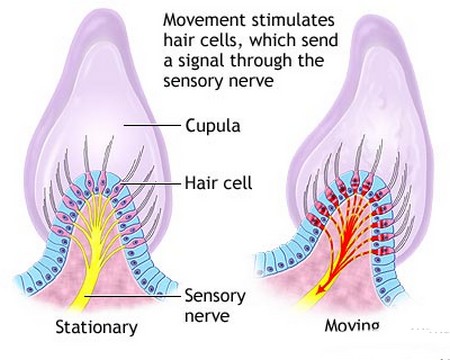You wake up in the middle of the night and sense that something is wrong. As you turn to your right side, you know, even in the dark, that the room is spinning wildly around you. You haven’t been transported to a scene from a Hitchcock movie; you’re a victim of vertigo.
One of the most common diseases of the inner ear is benign paroxysmal positional vertigo, or BPPV. It affects 15 to 40 percent of people who go to doctors for help with their dizziness. BPPV usually occurs for the first time between the ages of 30 and 50, and it’s twice as likely to strike you if you’re a woman.

When you have BPPV, it’s hard to concentrate on anything else. You just want an end to the horrible spinning sensation and nausea you get every time you turn your head the wrong way or try to lie down or stand up. But if your doctor diagnoses your dizziness as benign paroxysmal positional vertigo, you’re lucky. First, your ailment has a definite name and cause, and second, there’s something your doctor can do about it.
A tiny, complex system within your inner ear keeps your body in balance most of the time. BPPV occurs when calcium particles inside the mechanism float around or are knocked out of place and into the wrong position. When you move your head a certain way, it sends the wrong signals to your brain. This miscommu-nication results in vertigo, the feeling that the room is spinning violently around you. Nausea and sometimes vomiting are also part of the sensation. A blow to the head or a viral infection may cause BPPV, but usually you don’t know why it comes on.
If you do nothing and just live with the misery, BPPV should go away within a few months. But there’s no reason why you shouldn’t get help and get over it. When you go to your doctor, he’ll give you a test called the Hallpike maneuver to check for the condition. At this point, he’ll be watching your eye movements to help in his diagnosis. Now comes the surprising part.
If his medical knowledge is up-to-date, your doctor can perform a five-minute procedure called the Epley maneuver, named after the doctor who invented it. He’ll have you lie on the examining table with your head hanging off the end and turned toward the “bad” side. Then he’ll rotate your head 180 degrees. The turning action should pop the calcium particles out of their hiding place and back into the right location. The Semont maneuver is another process your doctor might use to reposition the “ear rocks.”
At home, you need to keep your head upright for 48 hours, even when you sleep. Look for the best recliner for sleeping or a sofa with fluffy pillows can help you sleep comfortably and at the correct angle. For at least a week, be extra careful in the way you move your head. Sleep on two pillows, don’t sleep on the “bad” side, and don’t do any exercises that move your head quickly, such as sit-ups or toe touches. Also, don’t go to the hairdresser or dentist, or bend your head while you shave or wash your hair.
Once your doctor has shown you the correct way to do the Epley maneuver, you can try it on your own if you have another run-in with BPPV. You must do it correctly, though, or you may lodge the calcium particles more firmly in the wrong place and prolong your vertigo.
Don’t live with dizziness if it seems the cause is as simple as BPPV. Get your doctor’s help. If your regular doctor doesn’t know the Epley maneuver, find one who does. An otolaryngologist, or “ear, nose, and throat” doctor should be able to help you stop the spinning.